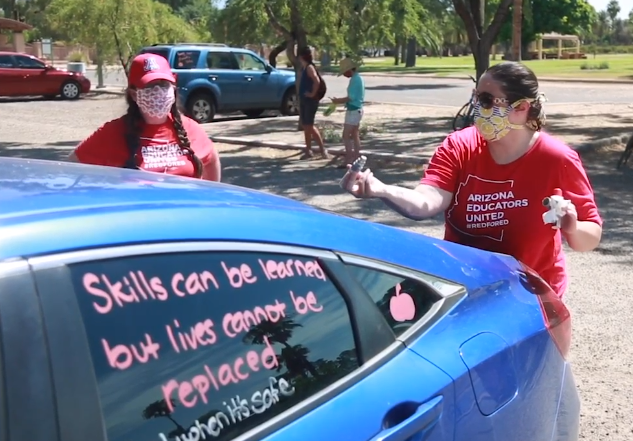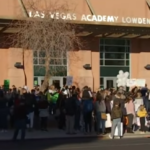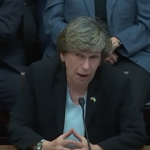Teacher unions’ entitlement mentality threatens school reopening efforts

As the coronavirus pandemic appears to continue into the upcoming school year, teachers and their unions across the United States refuse to return to classrooms to instruct students. Many school districts are slated to start in late August or early September, but with vocal teachers opposing reopening plans, school districts are stuck between a metaphorical rock and a hard place.
Some school districts have opted to host virtual online classes for at least the fall semester, while others such as New York City will have limited classroom capacity. Yet teachers oppose school reopening plans based on fears for their own health.
Teachers have anonymously or publicly declared that they fear school reopening plans due to the ongoing pandemic. One teacher-led petition in Oakland, California demanded that other teachers sign onto the premise that schools be closed until each county reported no new coronavirus cases occur for two straight weeks, or fourteen days. That specific petition would require an almost statistically-impossible scenario where no new cases would be reported in each county in the United States, which could suggest that the petition’s aim was to close school indefinitely without providing a real solution for teachers and parents.
Emboldened by successful teacher strikes during the past several years in Arizona, West Virginia, and Oklahoma, teachers assumed that they have significant leverage and the support of politicians and parents. But parents are also affected by school closures and a shift to virtual online learning. Teachers have not recognized the issues that school closures present parents, either from nuclear families or single-parent homes.
The truth is that public schools have operated as a type of child-care on the taxpayer’s dime. However, if schools do not hold regular classes and after-school activities, parents will have to sacrifice work hours at their full-time or part-time jobs to stay home and ensure that their children attend online courses. Also, some children are not old enough to stay home without an adult present, which could force families to make decisions whether to cut back their work hours or leave their job to stay home with their children.
The anti-school reopening movement also ignored the immediate health benefits of holding classes in urban and impoverished areas. In many inner-city neighborhoods, schools are the only place for children to eat a government-provided meal. If schools remain closed, it will be difficult to get the food to the children who need it most. There are stories of school districts handing out bagged meals for students at the start of the pandemic, but the students had to find their own transportation to get to the school. Students who rely on school buses would be unable to pick up their meals.
Statistics demonstrated that the majority of fatalities from the coronavirus are the elderly, obese, diabetic, and those with pre-existing health conditions. Children and young teenagers appeared to be unaffected by the coronavirus six months into the pandemic. Although reopening schools places some risk at the feet of administrators and teachers, the students will most likely be safe attending in-person classes.
For example, a British study discovered that 62% of infected children were admitted to hospitals, with only 8% needing intensive care treatment. Also, 87% of infected children did not need oxygen or breathing support and if there was a need for oxygen support, they were on oxygen for about a week. The authors found that the true child fatality rate was 0.69% in this case study and said that it was likely much lower than what the study found.
There is also a concern about the lack of internet access and safe locations for some children in urban areas. Though some school districts have provided laptops with internet access, it does not necessarily mean that each student will log into class at the appointed times. Not every student has internet access, particularly those in impoverished areas and those living in areas with limited internet service. Teachers and their unions have not decided how to resolve those problems if districts go 100% online.
School sports programs also provide an opportunity for students to apply for athletic scholarships at colleges or universities. Youth from inner-city communities rely on these scholarships to get an education, but with school closures, athletic seasons could be eliminated and they would lose the opportunity. A four-year degree at most public universities cost at least $5,000 per semester, or $10,000 a year excluding housing costs, food, and student fees. Private universities cost far more– in the tens of thousands per year, and students from poor backgrounds could never afford it without taking out significant loans. But athletic scholarships are an opportunity for students to get a college education, and without schools reopening on-time, all these opportunities are at risk.
Another important point that has not been covered is that unions have not addressed the overall problem of quality education. If schools are 100% virtual and students are unaccustomed to it, it is unclear whether the district is providing a quality education. Online learning is not for every student, and some thrive in familiar classroom settings. Online learning could set students back due to the ever-changing dynamics of online learning, and the inevitable technological issues that will occur with sustained internet and computer use. School districts already have a tough time graduating their students and the sudden shift to online learning could make graduation even harder for those without adequate educational support at home.
If teachers truly cared about their students, they would return to school and take the necessary precautions to limit infection. There are far too many damaging factors for their students if school facilities remained closed for the upcoming school year. Unions have consistently failed to address how school closures will benefit students and echo the same refrain that conditions would be too unsafe for their teachers.
Reopening schools will involve taking precautions such as frequent cleaning of schools, social distancing, use of masks, and limited classroom sizes. Teachers, like everyone else, should recognize that there is no situation that is risk-free. Though they have some legitimate concerns, teachers should not use the pandemic to push their own agendas at the expense of their students. If teachers do not want to work during the pandemic, they should find another profession, and understand that no single employee is irreplaceable, or they will find themselves replaced by more eager and unselfish teachers.




